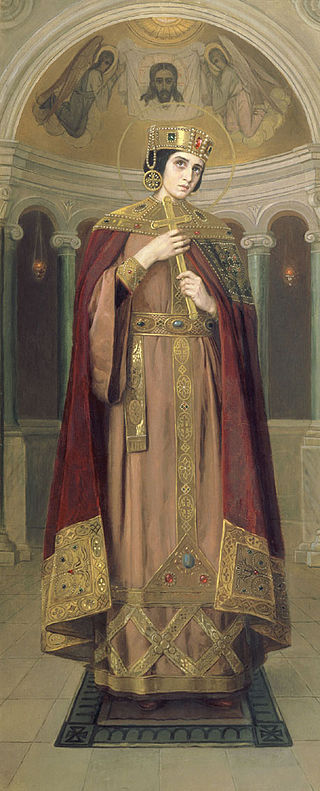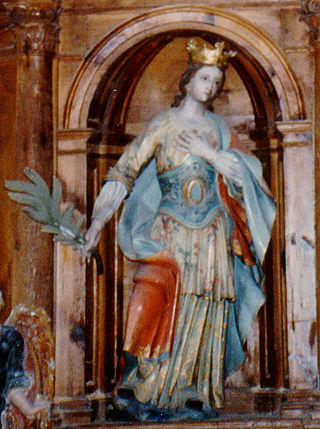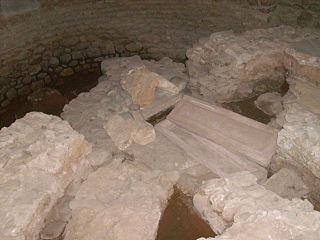
Saint Valentine was a 3rd-century Roman saint, commemorated in Western Christianity on February 14 and in Eastern Orthodoxy on July 6. From the High Middle Ages, his feast day has been associated with a tradition of courtly love. He is also a patron saint of Terni, epilepsy and beekeepers. Saint Valentine was a clergyman – either a priest or a bishop – in the Roman Empire who ministered to persecuted Christians. He was martyred and his body buried on the Via Flaminia on February 14, which has been observed as the Feast of Saint Valentine since at least the eighth century.

Conques is a former commune in the Aveyron department in Southern France, in the Occitania region. On 1 January 2016, it was merged into the new commune of Conques-en-Rouergue.

Peter of Verona, also known as Saint Peter Martyr and Saint Peter of Verona, was a 13th-century Italian Catholic priest. He was a Dominican friar and a celebrated preacher. He served as Inquisitor in Lombardy, was killed by an assassin, and was canonized as a Catholic saint 11 months after his death, making this the fastest canonization in history.

Saint Hermenegild or Ermengild, was the son of king Liuvigild of the Visigothic Kingdom in the Iberian Peninsula and southern France. He fell out with his father in 579, then revolted the following year. During his rebellion, he converted from Arianism to Chalcedonian Christianity. Hermenegild was defeated in 584 and exiled. His death was later celebrated as a martyrdom due to the influence of Pope Gregory I's Dialogues, in which he portrayed Hermenegild as a "Catholic martyr rebelling against the tyranny of an Arian father."

Saint Fructuosus of Tarragona was a Christian saint, bishop and martyr. His is an important name in the early history of Christianity in Hispania. He was bishop of Tarragona and was arrested during the persecutions of Christians under the Roman Emperor Valerian. Along with him were two deacons, St. Augurius and St. Eulogius. In 259, he was questioned by the praeses Aemilianus and burned at the stake in the local amphitheatre in Tarraco. The Acta of the martyrdom of the bishop Fructuosus and his deacons Augurius and Eulogius document his legend; they are the earliest Hispanic Acta, "marked by a realistic simplicity which contrasts very favourably with many of the Acta of Diocletian's persecution".

Saint Faith or Saint Faith of Conques is a saint who is said to have been a girl or young woman of Agen in Aquitaine. Her legend recounts how she was arrested during persecution of Christians by the Roman Empire and refused to make pagan sacrifices. Saint Faith was tortured to death with a red-hot brazier. Her death is sometimes said to have occurred in the year 287 or 290, sometimes in the large-scale Diocletianic Persecution beginning in 303. She is listed as "Sancta Fides, Virgin and martyr", in the martyrologies.

Saint Alban is venerated as the first-recorded British Christian martyr, for which reason he is considered to be the British protomartyr. Along with fellow Saints Julius and Aaron, Alban is one of three named martyrs recorded at an early date from Roman Britain. He is traditionally believed to have been beheaded in Verulamium sometime during the 3rd or 4th century, and his cult has been celebrated there since ancient times.

Zeno of Verona was either an early Christian Bishop of Verona or a martyr. He is a saint in the Catholic Church and in the Orthodox Church.

Victor of Marseilles was an Egyptian Christian martyr. He is venerated as a saint in the Catholic Church and the Eastern Orthodox Church.

October 5 - Eastern Orthodox liturgical calendar - October 7

October 19 - Eastern Orthodox liturgical calendar - October 21

Alexandra of Rome was a reputed Christian martyr and saint, known from Martyrdom of Saint George as either Emperor Diocletian's wife or the wife of Dacian, a Roman Prefect. She is also sometimes mistaken with Priscilla or Prisca.

Columba of Spain was a virgin and nun who was born in Córdoba, Spain, and martyred around 853 by the Muslim rulers in Spain, during a persecution of Christians. She is a part of the Martyrs of Córdoba and venerated as a saint in the Catholic Church. Her feast day is September 17. Her cult was probably a combination of two virgin martyrs, Colomba of Spain and Columba of Sens, a third century French martyr.
Saint Alberta of Agen was a Roman venerated as a martyr and saint. Supposed to have been one of the first victims of Diocletian's persecutions, she was tortured with Saint Faith and Saint Caprasius in Agen, France. According to tradition, some spectators objected to this, and were subsequently beheaded as well. Alberta is commemorated on March 11.

Saints Primus and Felician (Felicianus) (Italian: Primo e Feliciano) were brothers who suffered martyrdom about the year 304 during the Diocletian persecution. The Martyrologium Hieronymianum gives under June 9 the names of Primus and Felician who were buried at the fourteenth milestone of the Via Nomentana (near Nomentum, now Mentana).

Caprasius, sometimes Caprasius of Lérins, was a hermit who lived in Lérins, Provence.

Santa Cruz de la Serós is a village in the province of Huesca, Aragon, Spain. Located 88 kilometers from the city of Huesca, it is located at a hill side on the way to the Monastery of San Juan de la Peña.
Basilides and Potamiaena were Christian martyrs now venerated as saints. Both died in Alexandria during the persecutions under Septimius Severus.

San Caprasio is a church in Santa Cruz de la Serós, Jacetania, Spain, in First Romanesque style.
















